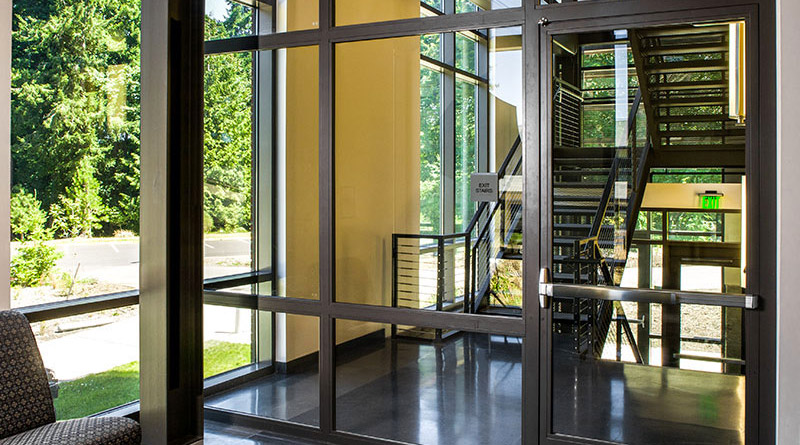Fire-rated Glass Advances Green Building Designs

Studies have shown that living and working in buildings illuminated by natural light can improve concentration and increase productivity. That’s why builders have started working with fire-rated glass to promote the use of natural light while constructing a sustainable and soothing environment.
Fire-rated glazing, one of the hottest trends in green building, works to meet fire codes while permitting daylight to flow through windows and doors. Thanks to new product developments, building teams can use it to create energy-efficient designs that provide fire protection while still maintaining an open and inviting look.
Fire-rated Glass Developments
Fire-rated glass was once synonymous with institutional-looking wired glass that was limited to 100 square inch panels. Although these vision lites allowed some light to transfer into and out of spaces, they did little to better the occupant’s overall environment.
When manufacturers developed fire-resistive glazing systems (those that defend against the transfer of flames, smoke and radiant and conductive heat) in the early 21st century, creating buildings to meet the needs of those who lived and worked in them became a reality. Fire-resistive glazing systems pass the test standards for solid walls, and can serve as a barrier to heat for extended time periods. As a result, building teams can use these advanced systems to create glazed areas that extend from floor-to-ceiling, wall-to-wall, and across multiple stories while occupants are protected from the heat generated by building fires.
Today, building teams can select from popular fire-resistive glazing systems such as; full-lite door assemblies, transparent glass walls, curtain walls, glass floors and roofs.
Design professionals can also select from two of the newest fire-resistive-rated glazing options on the market — silicone-glazed (SG) fire-rated curtain walls and butt-glazed, fire-rated framing systems. SG fire-rated curtain walls provide a smooth, frame-free exterior surface. They are ideal for applications where it is critical to match the smooth look of non-rated structural silicone glazed curtain wall systems. Butt-glazed, fire-rated systems are another design-forward option. They enable extensive fire-rated glazed walls with virtually uninterrupted views and can enhance light transmission.
Sustainable Design
By putting these high-performance, multipurpose fire-rated glazing products to use, building teams can further sustainable design goals in areas with stringent fire and life safety code requirements.
• Transparent building compartmentation
One of fire-rated glass’ primary benefits is the ability to provide transparent building compartmentation. Compartmentation, or the subdivision of spaces, is a crucial defense mechanism in schools, corporate offices and hospitals as it allows parts of the facility to be protected by fire proof glass walls without compromising on daylighting and overall design goals.
• Visual connectivity
Fire-rated glazing systems also have the ability to promote visual connectivity between workspaces and common areas. In schools, offices and hospitals, this prevents occupants feeling isolated, and encourages positive interaction, even in areas with strict fire and life safety requirements.
Today, there are many ways design teams can use fire-rated glazing to enhance transparency and create the feeling of open, shared spaces including; incorporating fire-rated glass panes in central corridors and gathering areas, using expansive fire-rated glass curtain walls to draw the line of sight through nearby expanses of glazing incorporating fire-rated glazing in fire-rated doors to promote visibility between spaces; and using exterior fire-rated glazing systems on the perimeter of buildings with lot line protection requirements.
By Jeff Razwick.
Jeff Razwick is the president of Snoqualmie, Wash.-based Technical Glass Products (TGP), a supplier of fire-rated glass and framing systems, and other specialty architectural glazing. He can be reached at www.fireglass.com or by calling (800) 426-0279.

